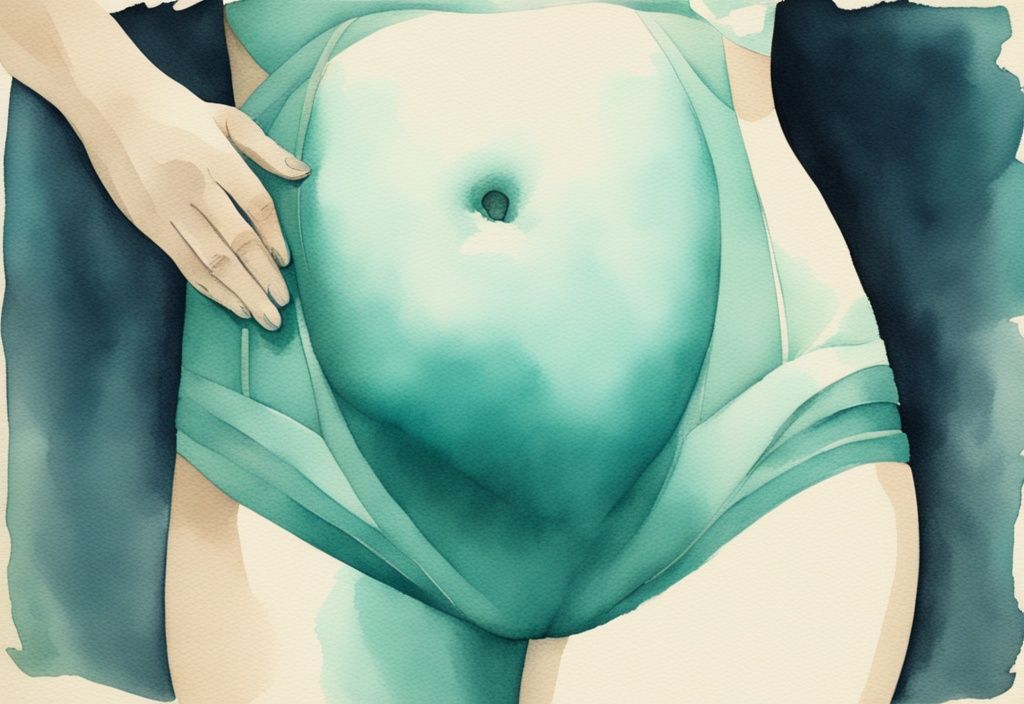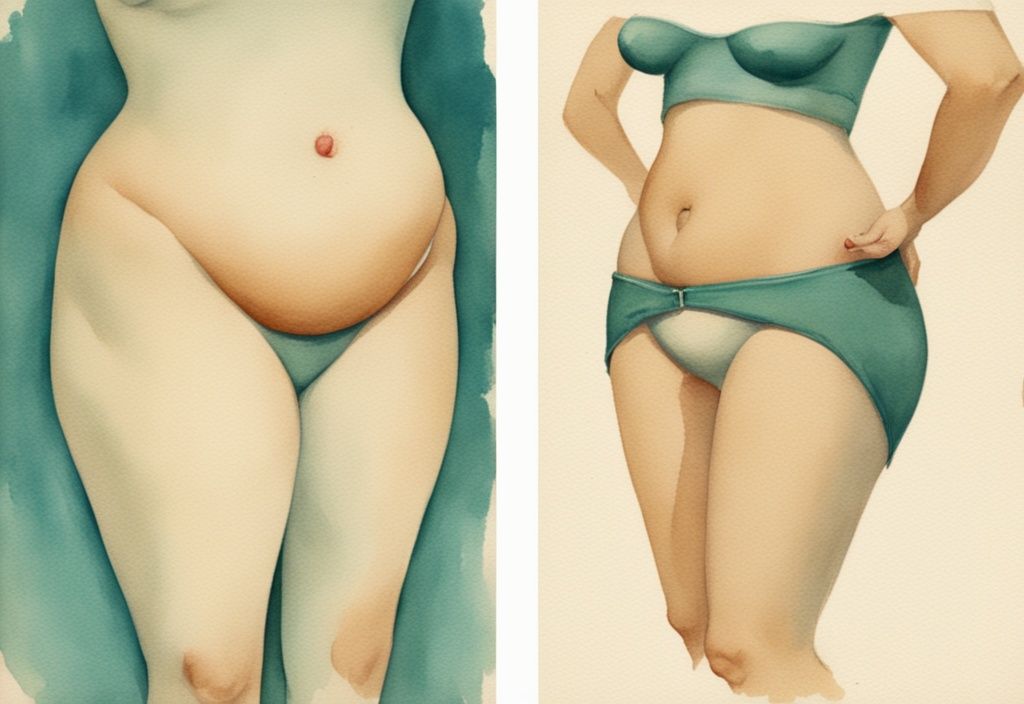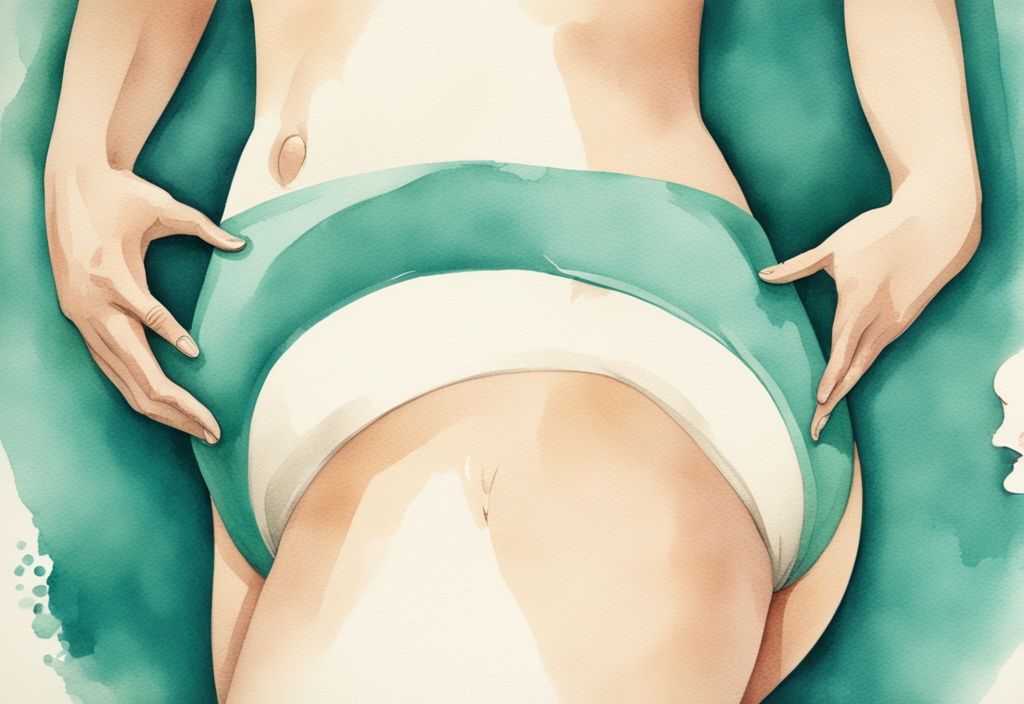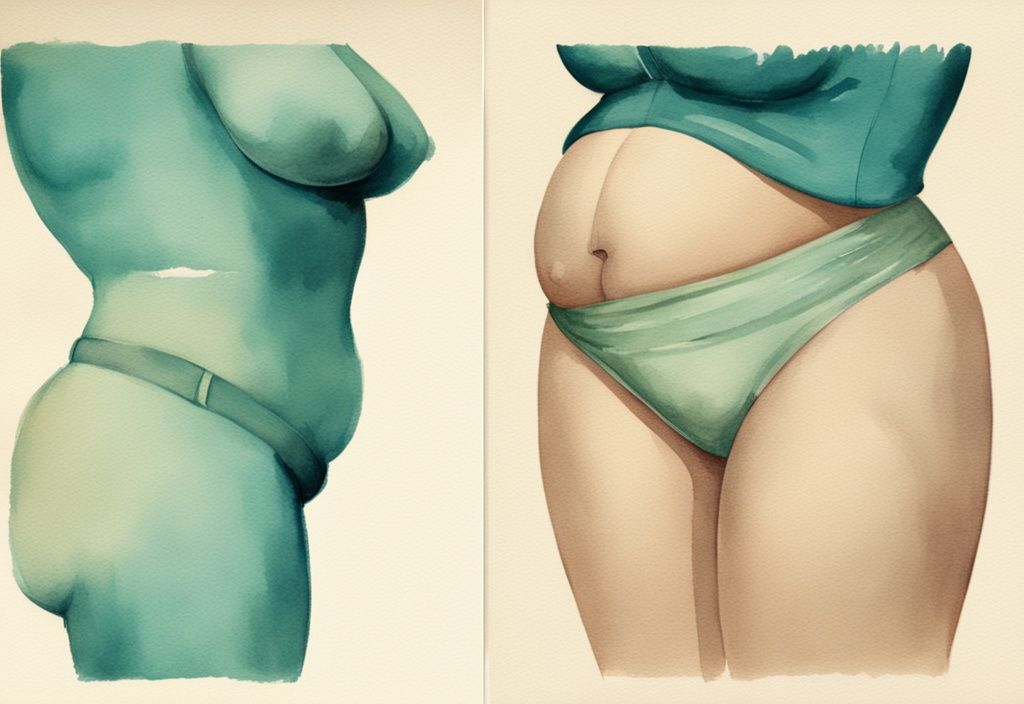Do you notice unusual triangular flaps of skin following your tummy tuck or “dog ears?” I totally understand. It’s like getting a gift you didn’t want. Worry not—we’ll sort it out together! We’ll delve into the why and how of dog ears formation, deciphering this strange surgical side effect.
No need to feel alone with your concerns. Heard of the phrase ‘forewarned is forearmed’? Well, that’s exactly how we’re going to approach this. I’ll walk you through recognizing dog ears, both surgical and non-surgical remedies, as well as prevention tips and recovery pointers.
Stay with me, and by the end of this, you’ll know exactly how to manage those pesky ‘dog ears’. Let’s navigate this journey to a smoother, more satisfying result together.
An Overview of Dog Ears in Tummy Tuck Procedures
In this section, we’ll dive into what dog ears mean in the context of tummy tucks, and how often they occur after abdominoplasty. You’ll get a better understanding of these small but sometimes pesky formations and why they might appear after your procedure.
What does ‘Dog Ears’ Mean?
Dog ears are those little flaps or triangular-shaped excess skin and fatty tissue that pop up at the ends of a surgical incision. You’ll typically see these after skin-tightening surgeries like tummy tucks (officially known as abdominoplasty), breast reductions, and breast lifts.
Picture it like this: Imagine two folds of skin creating what looks like a small mound or bulge near the end of a scar. This usually happens when the skin beyond the incision’s endpoint is looser than the tighter skin along the scar.
While they might sound cute (dog ears, after all!), they can interrupt the smooth look you’re hoping for after surgery. So, it’s super important to know what they are and consider ways to address them if they appear.
How Often does it Happen After Abdominoplasty?
About twenty percent of people who have undergone abdominoplasty experience these little dog ears at one or both ends of their scar. These tend to become more prominent when standing or sitting because that’s when the skin folds and creates more visible bulges.
Addressing dog ears is crucial for patient satisfaction. Nobody wants a bulgy surprise after their surgery! Ensuring they’re managed properly helps you get those smooth, seamless results you’ve been looking forward to.
This revised content now aligns with Lucy’s warm and conversational writing style.
Why Do Dog Ears Occur After a Tummy Tuck?
Excess skin and elasticity issues, along with specific surgical techniques, play critical roles in why dog ears appear after a tummy tuck.

Understanding these factors can help manage expectations and guide you toward better outcomes. To explore various procedures for removing excess skin, you can learn more here.
The Role of Excess Skin and Elasticity
Significant excess skin is often the main culprit behind dog ears after a tummy tuck. When there’s a lot of loose skin, it’s incredibly challenging for the surgeon to remove all of it without leaving some at the ends of the incision. This leftover skin can bunch up, forming those pesky little folds we call dog ears.
Think of skin like a stretchy piece of fabric. In cases where the skin isn’t stretchy enough, it struggles to fit snugly around your body’s new shape post-surgery. This lack of elasticity makes the skin form unwanted folds, causing those dog ear mounds to appear. This scenario is more common in older patients or individuals who’ve experienced significant weight changes. The skin’s ability to “bounce back” is compromised, making it harder to achieve a smooth, even surface after the procedure.
Impact of Surgical Techniques
Surgical techniques are another significant factor in the formation of dog ears. Improper suturing can lead to uneven tension along the incision line, causing the skin at the ends to bulge or fold, creating these unwanted protrusions. When the tension isn’t uniformly distributed, the risk of developing dog ears increases.
Moreover, if the surgeon doesn’t remove enough skin during the initial surgery, residual loose skin can gather at the incision ends, causing excess folds to develop. Precision and adequate skin removal are crucial; otherwise, leftover skin can spoil the aesthetic result, leading to visible dog ears.
Choosing an experienced, skilled surgeon is vital, as their expertise in surgical techniques can significantly reduce the incidence of dog ears.
Recognizing Dog Ears: Signs and Symptoms
Understanding what are dog ears after tummy tuck procedures well, let’s dive into recognizing these pesky little folds. Dog ears may seem harmless, but they can be a bit of a nuisance for those striving for a smooth, contoured look post-surgery. The following sections will help you identify them and understand their impact.
How to Spot Dog Ears
One key to understanding what are dog ears after tummy tuck procedures is knowing how to identify them. They present as small, protruding folds of skin and fatty tissue positioned at the ends of a surgical scar. The distinctive characteristic of dog ears is their triangular or mound-like shape, making them relatively easy to spot. This protrusion becomes more apparent particularly when the skin is in a relaxed state, making the contour irregular and bulged compared to the surrounding area.
Does it Affect the Cosmetic Result?
Although not medically harmful or dangerous, dog ears can significantly impact the cosmetic outcome of a tummy tuck. Many patients find these protruding skin folds cosmetically unappealing and feel dissatisfied with the overall look of their surgical results. The presence of dog ears can detract from the smooth, contoured appearance typically desired after an abdominoplasty, leading patients to seek corrective options to enhance their aesthetic satisfaction.
Dealing with Dog Ears After a Tummy Tuck: Treatments and Corrections
Dealing with those little extra folds, often called dog ears, that appear after a tummy tuck can be a real challenge. Luckily, there are several treatments and corrections available to help smooth things out and bring back that confident feeling.
Surgical Solutions for Dog Ears
Dog ears, those pesky small protruding folds of skin and fatty tissue at the ends of a surgical scar, can often be effectively addressed through minor surgical interventions. These corrections are usually straightforward and are performed under local anesthesia, meaning you’ll be awake but the area will be numbed.
The procedure involves reopening a small portion of the scar, carefully removing any excess skin, and precisely re-suturing the area to ensure a smooth contour along the incision line.
Reshaping the Scar
Reshaping the scar is crucial for achieving a symmetrical and flat appearance. The surgeon will make precise cuts to adjust the scar’s shape, ensuring that the skin lays flat without any protruding flaps. This meticulous approach helps blend the incision more seamlessly with the surrounding skin, thereby reducing the visibility of dog ears and enhancing the overall aesthetic outcome of the surgery.
Liposuction as a Treatment Option
In cases where fatty tissue contributes to the formation of dog ears, liposuction can be an effective treatment option. This technique involves using a small, specialized tube to suction out unwanted fat in the affected area, thereby smoothing out the contours. Liposuction specifically targets small fat deposits that aren’t solely due to loose skin, making it an important complementary procedure to scar reshaping for optimal results.
Alternatives to Surgery
For minor cases of dog ears, non-surgical treatments may be a viable option to consider. Steroid injections can help soften and flatten the protruding skin, minimizing the dog ears’ appearance without the need for incisions.
Similarly, laser treatments can tighten the skin and promote better contouring by stimulating collagen production. These non-invasive methods can offer significant improvements, especially for those hesitant about undergoing additional surgical procedures.

Recovering from Dog Ear Correction
Jumping back into the groove after a dog ear correction following a tummy tuck can be a smooth ride if you know what to expect. Let’s dive into the best timing for the procedure and the recovery journey.
When is the Best Time for Correction?
Dog ear correction is generally performed about six months after the initial tummy tuck surgery. This timeframe is crucial to ensure that all postoperative swelling has subsided, allowing for precise adjustments.
Correcting dog ears too early may yield suboptimal results because the tissues might still be inflamed or settling into their final positions. Waiting for this period ensures that surgeons can achieve the best possible cosmetic outcome, as the skin and underlying tissues will be in a state conducive to precise modification. Patience here truly pays off.
What to Expect During Recovery?
After a dog ear correction procedure, you can typically expect a swift recovery period. Imagine being back on your feet and resuming your normal activities within just a few days! The discomfort associated with this minor surgical adjustment is usually minimal and can be effectively managed with over-the-counter pain medications.
Since the procedure often takes place under local anesthesia with minimal invasiveness, the healing process is relatively smooth. This means you can quickly enjoy the improved aesthetic results.
Regular follow-ups with the surgeon will ensure that the healing is progressing as expected and address any concerns promptly. Think of these check-ins as a friendly chat to keep everything on track!
How to Prevent Dog Ears After Tummy Tuck
When it comes to recovering from a tummy tuck, one key concern is preventing those pesky ‘dog ears’—those little bulges that can appear at the ends of your incision. Let’s dive into some effective ways to keep them at bay, ensuring your tummy tuck results are as smooth as your pup’s fur.
Effective Surgical Techniques to Prevent Dog Ears
Precise surgical techniques and proper planning are essential to preventing dog ears after a tummy tuck. Surgeons can help the skin conform more seamlessly post-surgery by ensuring the incision follows natural skin creases.
One particularly effective method involves using progressive tension sutures. These nifty sutures distribute tension more evenly along the incision line, reducing the chances of uneven pulling on the skin—a primary reason dog ears form.
It’s also crucial for surgeons to meticulously remove the right amount of skin, ensuring there’s no excess left at the ends of the incision. This balance between skin removal and tension distribution is key. By doing so, surgeons help avoid those unsightly protrusions that nobody wants to deal with after a tummy tuck.
Significance of Post-Operative Care
Sticking closely to post-operative care instructions is a game-changer for preventing complications, including dog ears. Following your surgeon’s guidance can make a world of difference in how you heal.
Avoiding strenuous activities and giving your body the time it needs to heal properly can help the skin settle, reducing the risk of dog ears. Maintaining a stable weight is also a biggy—dramatic weight fluctuations can stretch or loosen the skin, undoing the surgery’s effects.
And don’t forget about good skin care habits! A proper routine helps promote elasticity. Work closely with your healthcare provider to monitor your recovery. This way, you can ensure you’re on track for a smooth and aesthetically pleasing result.
Selecting the Right Surgeon and Ensuring Satisfaction
Choosing the right plastic surgeon and taking proactive measures can significantly enhance your experience and minimize the risk of complications like dog ears after a tummy tuck. Let’s explore the key steps to ensure satisfaction with your procedure.
The Art of Finding a Certified Plastic Surgeon
When it comes to tackling the question of what are dog ears after tummy tuck, selecting a highly qualified surgeon is paramount. Opt for a board-certified plastic surgeon who boasts extensive experience specifically in tummy tuck surgeries. Certification, especially from reputable boards like the American Board of Plastic Surgery, serves as a solid indicator of the surgeon’s expertise and commitment to high standards.
Diving into a surgeon’s track record can offer valuable insights. Look for those who have demonstrated success in tummy tuck procedures and feature glowing patient testimonials. These reviews don’t just spotlight technical skills but also give a peek into the surgeon’s bedside manner and the overall patient experience. Surgeons with a strong history of satisfied patients are more likely to skillfully handle and, if necessary, correct issues like dog ears.
Lifestyle Choices to Ensure Optimal Results
Maintaining the best aesthetic outcomes post-tummy tuck—and keeping dog ears at bay—calls for some dedicated lifestyle choices. Keeping a stable weight is key, as significant weight fluctuations can exacerbate skin folding. Additionally, proper skin care is vital; healthy skin is more elastic and less prone to forming protruding flaps.
It’s also crucial to follow your surgeon’s guidelines for long-term care. These could include tips on diet, exercise, and specific skin care routines. For pet owners, understanding changes in your dog’s health is equally important, such as when you’re wondering, “why is my dog pooping so much”. Sticking to these recommendations can make a significant difference in your recovery and the longevity of your surgical results. This blend of a skilled surgeon and a commitment to post-op care can help you achieve the best possible outcome, minimizing complications like dog ears after tummy tuck procedures.

FAQs on Dog Ears After Tummy Tuck
Dealing with dog ears after a tummy tuck can be a bit of a hiccup, but don’t fret. Let’s dive into some of the most common questions and clear things up.
What Causes Dog Ears After a Tummy Tuck?
Dog ears after a tummy tuck pop up due to various reasons. Significant excess skin is a major culprit. If there’s poor skin elasticity or improper suturing techniques, these tiny, protruding skin folds are more likely to form at the ends of the incision. It’s also possible that not enough skin was removed during the surgery, leaving these little unwanted folds.
Are Dog Ears Harmful?
Thankfully, dog ears aren’t dangerous or medically harmful. They usually don’t cause any physical discomfort. However, they can be a bit of a bummer when it comes to the final look of your tummy tuck results. It’s mostly about the cosmetic finish.
How Soon Can Dog Ears be Corrected?
Patience is key here. Dog ear corrections are typically done around six months after the initial tummy tuck. This waiting period ensures that all swelling has gone down, leading to better precision and outcomes during the correction procedure. So, hang in there a little longer for the best results!
Can Dog Ears be Treated Non-surgically?
Yes, absolutely. For minor cases, there are non-surgical options available. Treatments like steroid injections or laser therapy can help minimize the appearance of dog ears without the need for additional incisions. They’re great for those who want to avoid another round under the knife.
What Steps Help Prevent Dog Ears Formation?
Preventing dog ears starts with precise surgical techniques. Using progressive tension sutures can help distribute the tension evenly across the skin. Proper skin removal and carefully following post-operative care instructions are also crucial. These steps together can keep those pesky folds at bay.
How to Choose a Surgeon for Dog Ears Correction?
When looking for a surgeon to correct dog ears, opt for a board-certified plastic surgeon with plenty of tummy tuck experience. Check out their patient reviews and make sure they have specific expertise in handling and correcting dog ears. The right surgeon can make a world of difference in achieving the best possible outcome.
Wrapping Up
Understanding what are dog ears after tummy tuck is crucial for anyone considering or recovering from this procedure. These small, triangular-shaped excess skin and fatty tissue at the ends of a surgical incision can mar otherwise stellar results. However, with appropriate surgical techniques, the likelihood of developing dog ears can be significantly reduced.
A skilled surgeon who employs precise suturing and ensures adequate skin removal will greatly minimize this risk. Additionally, adhering to effective post-operative care, maintaining a stable weight, and following the surgeon’s guidelines are vital to sustaining the desired contour of your body post-surgery.
For those who already experience what are dog ears after tummy tuck, several correction methods are available.
- Surgical solutions such as scar reshaping or liposuction can effectively address the issue.
- Minor cases may even be treated non-surgically through steroid injections or laser treatments, providing options tailored to different severity levels.
By being informed and proactive, you can achieve and maintain the aesthetic results you desire, making your journey through a tummy tuck more rewarding and satisfactory.
Imagine this: you’re out walking with your furry friend, feeling light and confident. Navigating the post-tummy tuck terrain might seem daunting, but these insights can truly make a difference, offering peace of mind and clarity.
Remember, a stable weight and paying close attention to your surgeon’s post-op guidelines are essential. With the right approach and care, you’ll be on your way to enjoying life, free from the worries of those pesky “dog ears.”
